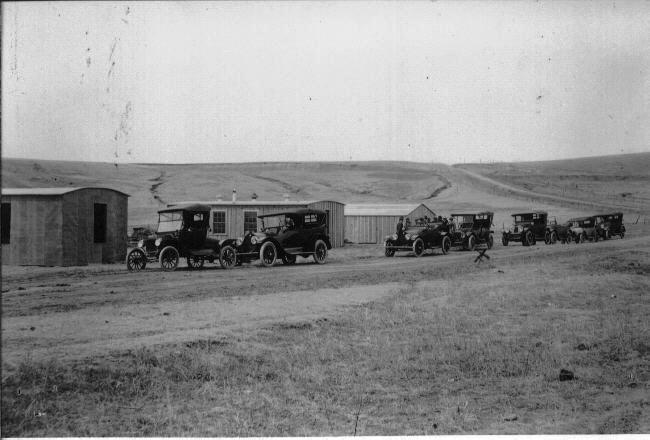Ranchers
Even before Matt France and Judge McFerran had opened their mines, the first of the great cattle herds to be trailed to Denver and Cheyenne passed through Jimmy Camp. In an article for the El Paso County Heritage, Walter Dennis - himself a Jimmy Camp cowboy - tells of his great, great grandfather who kept cattle during the 1860's and 70's near the Brazos River wouthwest of Fort Worth, Texas. Two of his grandfather's nighbors were Charles Goodnight and Oliver Loving. In 1866 these two ranchers began bringing together large numbers of cattle to be herded to the markets at the railheads. The first drive to Colorado Territory was through New Mexico and over Raton Pass. Eighteen armed cowboys moved the 2,000 head of cattle across the Arkansas River near Pueblo and up the old Ckerokee Trail to Jimmy Camp. The herd was first watered at Jimmy Springs, then bedded down for the night in Corral Valley to the northeast.
In succeeding years the Goodnight cattle trail was moved eastward by way of Trinchera. Pass. The route through El Paso County was east of Peyton. Even so, Walter Dennis writes that it was not uncommon, during the days of the open range, for herds of cattle to be driven up from the Arkansas Valley to the markets in Denver by way of Jimmy Camp. Jimmy Springs again served as one of the main watering troughs.(1)
These cattle drives came to an end with the expansion of the railroads and the consequent settlement of the Pikes Peak region. During the 1880's and 90's the plains surrounding Jimmy Camp became dotted with ranches. Even as these ranches developed the old trail became ever more restricted to local traffic. That portion of the Cherokee Trail passing through Jimmy Camp - from the town of Fountain in the south to beyond Black Forest in the north - became known as the Jimmy Camp Road. But eventually, as new and better roads were constructed, even this Jimmy Camp Road fell into general disuse. By the late 1890's much of the road was nothing but a memory. Here and there were traces in the form of a series of foot-deep ruts, paralleling each other, and covering a width of perhaps a hundred feet. Gradually, even these ruts disappeared.
A portion of the Jimmy Camp Road was destined to be preserved as a ranch road, when the area surrounding Jimmy Springs was converted to ranchland. About 1882 miner Matt France sold his Jimmy Camp holdings to James D. Lawson. The era of the ranchers had begun. In the 1870's and 80's an annual roundup was held in the vicinity of Jimmy Camp. The roundup of 1875 was bossed by A.N. Hunter, later a well-known banker in Leadville. The cattle were collected and cut out a couple of miles to the northeast of the springs, in a natural amphitheater of hills known as Corral Bluffs.
Corral Bluffs and Jimmy Camp saw many a roundup over the next hundred years. Lawson sold out to E.W. Giddings, owner of the Giddings' Dry Goods in Colorado Springs. George W. Benedict then bought the proprty and in turn sold it to J.L. McMahon, owner of the Alamo Hotel. Even though he operated Jimmy Camp as a ranch, McMahon was not unaware of its other commercial possibilities. He and his wife later converted the area near the springs into a health and pleasure resort known as Richland. It is said that they used the story-and-a-half log cabin of Marmaduke Green as a stable.(2)
In 1912 McMahon seems to have been prevailed upon by Colorado Springs merchants to let them build a series of road houses on Jimmy Camp land alongside the Old Farmers' Highway, now known as Highway 94. These road houses seem to have been built to provide a free night's stay for farmers traveling to Colorado Springs for supplies.
 Jimmy Camp Road Houses
Courtesy: Colorsdo Springs Pioneers Museum
Jimmy Camp Road Houses
Courtesy: Colorsdo Springs Pioneers Museum
Jimmy Camp reverted solely to ranch use in the 1920's. In 1921 a Fowler rancher by the name of Raymond W. Lewis ("Pinky" to his friends) married Ruth Banning, owner of the Banning Ranch located south of Colorado Springs. The two became joined in a business partnership as well as a marriage. They began buying up several small ranches east of Colororado Springs on which to raise their registered Herefords. Included in the 30,000 acres of purchased ranchland was the 1,000 acres surrounding Jimmy Camp.
The ranch at Jimmy Camp was developed along with the other properties. Two mansions from Nevada Avenue in Colorado Springs were moved to an area along Jimmy Camp Creek, a mile southwest of the springs. Barns and other outbuildings were constructed nearby. In the early 1940's a railroad car was placed atop Jimmy Camp Bluffs on the south side of Highway 94. This car was rumored to have once been the private car of either General William Palmer or President Wilson. In fact, the car once belonged to the old Midland Railroad. Pinky Lewis stipulated that no greenery be disturbed in the process of moving the car, so three cranes were employed to pass the car over the tops of the trees. This railroad car was used for many years during the annual men's barbecue.
 Jimmy Camp Bluffs
Jimmy Camp Bluffs
For several decades about 2,000 registered Herefords were run on the Banning-Lewis Ranches. In the spring these cattle were driven to the pastures north of Highway 24; they were wintered on the pastures at the south end of the ranch, inluding the Curry and Watson pastures on the hills above Jimmy Springs. The abundance of timber provided good protection from the snow. The springs themselves provided open water. Eventually, Jimmy Springs was dug out to form a small circular reservoir; the area was fenced and a pipe run to a nearby tank so as to supply a never-ending source of cool spring water for the cattle. In 1969 most of the registered Herefords were sold to Robert Norris, owner of the T-Cross Ranches. Commercial Herefords - branded with a Quarter Circle Triangle - took their place. At the time of the sale of the Banning-Lewis Ranches in the mid-1980's, fifty cattle were being pastured on the Jimmy Camp Ranch.(3)
Next Page
Home Page
©1999 2000 Richard Gehling
E-mail me.
FOOTNOTES -
(1) - See Walter Dennis, "Five Generations of Cowboys," El Paso County Heritage, by Juanita L. and John P. Breckenridge (Curtis Media Corp., 1985), pp.20-24.
(2) - See Cragin Collecion, Colorado Springs Pioneers Museum.
(3) - Much of this information on the Jimmy Camp Ranch came from a June 1988 conversation with Thomas Dines, stepson of Raymond Lewis.


